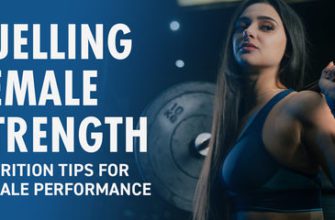Engaging in physical activities and striving for optimal fitness levels are essential aspects of a woman’s well-being. However, the intricate relationship between hormonal fluctuations and exercise performance often goes unnoticed. Unraveling the intricate mechanisms that underline the impact of hormonal activity on women’s athletic abilities is crucial to understanding their immense potential and harnessing it effectively.
Unlocking the Power of Hormones
Revolutionize Your Health & Lifestyle!
Dive into the world of Ketogenic Diet. Learn how to lose weight effectively while enjoying your meals. It's not just a diet; it's a lifestyle change.
Learn MoreIt is no secret that hormones play a crucial role in a woman’s life, influencing various aspects of her physical and emotional well-being. These powerful chemical messengers are released by the endocrine system and are responsible for regulating numerous bodily functions, including metabolism, cell growth, and reproductive health. What is often overlooked, however, is how hormones impact women’s fitness levels and their overall athletic performance.
The Hormonal Symphony of Fitness
Just as an orchestra relies on the synchrony of different instruments to create a beautiful symphony, a woman’s physical performance is intricately orchestrated by her hormones. Hormones such as estrogen, progesterone, and testosterone work in harmony, affecting energy levels, muscle strength, and recovery periods. The delicate balance and interplay of these hormones determine a woman’s ability to push boundaries and achieve remarkable feats in various physical activities.
- The Influence of Hormones on Women’s Fitness
- The Role of Hormones in Performance
- Understanding the Biological Impact
- 1. Unraveling the Intricacies of Hormonal Balance
- 2. Harnessing the Power of Hormones for Fitness Goals
- 3. The Menstrual Cycle: A Critical Factor in Women’s Fitness
- 4. Beyond Reproduction: Hormones and Overall Health
- Exploring the Link between Hormone Levels and Athletic Performance
- The Effects of Hormones on Muscle Development
- Hormonal Changes during Different Phases of the Menstrual Cycle
- The Impact of Estrogen and Testosterone on Muscle Strength and Endurance
- The Influence of Hormones on Energy Levels
- The Role of Cortisol in Stress and Recovery
- Questions and answers
The Influence of Hormones on Women’s Fitness
Understanding the interplay between hormones and women’s fitness is crucial in unraveling the complex relationship between physiological factors and performance. Hormones, the chemical messengers within the body, have a profound impact on a woman’s athletic abilities and overall fitness levels. By closely examining the influence of hormones on various aspects of women’s fitness, we can gain insights into optimizing training methods and tailoring exercise routines to maximize potential.
| Aspect | Hormonal Influence |
|---|---|
| Energy Metabolism | Hormones play a key role in regulating energy metabolism, impacting the utilization of carbohydrates, fats, and proteins for fuel during exercise. Hormonal fluctuations can affect energy availability, influencing endurance and performance outcomes. |
| Muscular Strength | Hormonal fluctuations, such as changes in estrogen and testosterone levels, can affect muscle protein synthesis, muscle mass, and muscle fiber type composition. Understanding these hormonal influences can aid in designing targeted strength training programs for women. |
| Recovery and Adaptation | Hormonal balance plays a crucial role in the recovery and adaptation processes following exercise. The fluctuation of hormones, such as cortisol and growth hormone, can affect muscle repair, tissue regeneration, and overall recovery time. |
| Bone Health | Hormonal imbalance, particularly a decline in estrogen levels during menopause, can impact bone health in women. Understanding the hormonal influence on bone density and the risk of osteoporosis can help in developing appropriate exercise and lifestyle interventions. |
| Cardiovascular Health | Hormonal factors, such as estrogen, play a vital role in cardiovascular health. Hormonal changes throughout the menstrual cycle can influence heart rate, blood pressure, and vascular function, affecting women’s cardiovascular fitness and exercise performance. |
By comprehending the intricate relationship between hormones and women’s fitness, we can empower women to optimize their training strategies, improve performance, and attain overall well-being. Delving into the influence of hormonal factors on various aspects of fitness helps in devising personalized approaches that address the unique physiological needs of women.
The Role of Hormones in Performance
In the realm of athletic performance and physical fitness, an intricate interplay exists between the internal workings of the human body and its ability to achieve optimal results. Central to this dynamic is the role of hormones, the chemical messengers that regulate various physiological processes.
These influential substances synchronize and facilitate a range of functions, exerting their effects through the bloodstream to reach target tissues and organs. Hormones play a pivotal role in modulating energy levels, muscle growth, metabolism, and recovery, ultimately shaping an individual’s physical performance.
One crucial group of hormones involved in performance enhancement includes anabolic hormones such as testosterone, growth hormone, and insulin-like growth factor 1 (IGF-1). These hormones stimulate protein synthesis, leading to muscle hypertrophy and increased strength. Additionally, they promote the body’s ability to repair and rebuild tissues, aiding in recovery and the prevention of injuries.
On the other hand, catabolic hormones like cortisol have a more pronounced role in regulating the body’s response to stress. While cortisol is essential for maintaining homeostasis and providing energy during intense physical activity, chronically elevated levels can hinder performance and impede muscle growth. Finding the right balance between anabolic and catabolic hormones is crucial for optimizing athletic performance.
In addition to anabolic and catabolic hormones, female athletes must also consider the influence of reproductive hormones, particularly estrogen and progesterone. These hormones fluctuate throughout the menstrual cycle and can impact physical performance. Estrogen plays a role in calcium metabolism and neuromuscular control, affecting muscle function. Progesterone, on the other hand, may contribute to increased core temperature and changes in cardiovascular responses, potentially affecting exercise capacity.
Understanding the intricacies of hormonal regulation and how it affects performance can empower female athletes to tailor their training, recovery, and nutrition strategies accordingly. By recognizing the role of hormones in shaping physical performance, athletes can optimize their training programs, maximize their potential, and achieve their fitness goals.
Understanding the Biological Impact
The influence of hormones on women’s physical well-being is undeniable. When considering the effects of these powerful chemical messengers, it becomes apparent that they play a crucial role in shaping women’s fitness levels. By delving into the realm of biological impact, we can unveil the intricate mechanisms that drive women’s performance and overall health.
1. Unraveling the Intricacies of Hormonal Balance
- Exploring the intricate interplay between hormonal fluctuations and fitness.
- Analyzing the significance of hormonal balance in optimizing performance.
- Highlighting the impact of fluctuations in estrogen, progesterone, and testosterone levels on women’s physical capabilities.
2. Harnessing the Power of Hormones for Fitness Goals
- Examining how specific hormones can be utilized to enhance physical performance.
- Unveiling the role of estrogen in muscle strength and endurance.
- Understanding the effects of progesterone on energy levels and recovery.
- Exploring the impact of testosterone on muscle development and metabolism.
3. The Menstrual Cycle: A Critical Factor in Women’s Fitness
- Creating an in-depth understanding of the menstrual cycle and its effects on performance.
- Investigating the menstrual cycle phases and their impact on energy levels, strength, and endurance.
- Highlighting strategies to adapt training and nutrition based on menstrual cycle fluctuations.
4. Beyond Reproduction: Hormones and Overall Health
- Exploring the wider implications of hormonal balance on women’s overall well-being.
- Discussing the connection between hormonal imbalances and various health conditions.
- Examining the potential role of exercise and lifestyle modifications in hormone regulation.
By comprehending the intricate biological impact of hormones, women can unlock their true potential and optimize their fitness journey. It is imperative to recognize the significant role hormones play and embrace the science behind their influence on women’s physical performance.
Exploring the Link between Hormone Levels and Athletic Performance
In this section, we delve into the connection between hormone levels and the ability to excel in athletic activities. We investigate the intricate relationship between the natural substances produced by women’s bodies and their impact on sports performance.
It is widely acknowledged that hormone levels play a significant role in shaping various aspects of women’s physical capabilities. This includes fundamental physiological functions such as muscle growth, endurance, and the regulation of metabolism. By exploring the intricate balance of hormones within the female body, we can uncover the potential ways in which these fluctuations influence athletic performance.
One crucial hormone to consider is estrogen, which is responsible for promoting bone health and overall strength. Its presence in higher levels has been associated with improved athletic performance, particularly in activities requiring agility and coordination. On the other hand, an excess or deficiency of estrogen can lead to potential imbalances, which may hinder physical abilities.
Another hormone of interest is progesterone, which fluctuates naturally throughout the menstrual cycle. Progesterone influences the body’s response to exercise, influencing factors such as muscle recovery and fatigue. Understanding how progesterone levels affect performance can provide valuable insights into optimizing training routines and avoiding potential setbacks during specific phases of the menstrual cycle.
Cortisol, often referred to as the stress hormone, also plays a role in athletic performance. While it is essential for the body’s response to stress, elevated levels can have detrimental effects on muscle strength, endurance, and recovery. Exploring the relationship between cortisol and athletic performance can help athletes manage their stress levels effectively to maximize their training outcomes.
By considering these influential hormones and their impacts on athletic performance, we can shed light on the complexities of women’s fitness. Acknowledging and understanding these connections can empower women to optimize their athletic potential and make informed decisions about their training regimens.
The Effects of Hormones on Muscle Development
Hormones play a crucial role in shaping muscle development, influencing the growth, strength, and efficiency of muscles within the body. These chemical messengers, inherent to the intricate workings of the female physiology, contribute significantly to the overall performance and physical abilities of women engaged in fitness activities and sports.
| Hormone | Role in Muscle Development |
|---|---|
| Estrogen | Estrogen not only affects sexual development and reproductive health, but it also contributes to muscle health in women. It plays a role in maintaining muscle strength, reducing muscle damage, and aiding muscle repair processes. |
| Progesterone | Progesterone, primarily associated with the menstrual cycle and pregnancy, also impacts muscle development. It aids in maintaining muscle mass, promoting muscle recovery, and reducing exercise-induced muscle damage. |
| Testosterone | Although predominantly considered a male hormone, testosterone also exists in females, albeit at lower levels. It plays a critical role in muscle development, influencing muscle mass, strength, and power. Proper testosterone levels support efficient muscle protein synthesis and aid in the growth and maintenance of lean muscle mass. |
| Growth Hormone | Growth hormone, produced by the pituitary gland, stimulates muscle growth and repair. It boosts protein synthesis, increases collagen production, and enhances the overall regenerative capacity of muscles. Adequate levels of growth hormone contribute significantly to muscle development and recovery. |
| Insulin-like Growth Factor 1 (IGF-1) | IGF-1 is a hormone that interacts closely with growth hormone to promote muscle growth and development. It stimulates the proliferation and differentiation of muscle cells and aids in muscle repair processes. In addition to its impact on muscle, IGF-1 also influences bone health and metabolism. |
In conclusion, understanding the effects of hormones on muscle development is vital for women looking to enhance their fitness and athletic performance. The interplay of estrogen, progesterone, testosterone, growth hormone, and IGF-1 contributes to muscle strength, repair, growth, and overall muscular health. By recognizing and optimizing these hormonal factors, women can better tailor their fitness routines and achieve their desired physical outcomes.
Hormonal Changes during Different Phases of the Menstrual Cycle
The fluctuations in hormonal levels that occur during the various phases of the menstrual cycle have a significant impact on women’s overall fitness and exercise performance. These hormonal changes, occurring naturally within the female body, can create distinct physiological and psychological variations that can influence an individual’s workout intensity, stamina, and muscle recovery. Understanding the complex interplay between hormones and fitness during each phase of the menstrual cycle is crucial for optimizing women’s training programs and achieving optimal results.
During the follicular phase, which typically lasts from the first day of menstruation to around day 14, estrogen levels begin to rise, stimulating the growth of ovarian follicles. This increase in estrogen can enhance carbohydrate metabolism and oxygen utilization, leading to improved endurance and aerobic capacity. Additionally, estrogen helps to maintain bone health and joint stability, reducing the risk of injuries during intense exercise.
In the ovulatory phase, which occurs around day 14, luteinizing hormone surges, triggering the release of the mature egg from the ovary. This phase is characterized by a significant increase in estrogen and a smaller rise in progesterone. High estrogen levels during this phase have been linked to improved muscle protein synthesis, muscle strength, and power output. Women may experience increased energy levels and may find it easier to push themselves during high-intensity workouts.
The luteal phase, which begins after ovulation and lasts until the start of the next menstrual period, is characterized by higher levels of progesterone than estrogen. Progesterone has a calming effect on the body, reducing anxiety and improving mood. However, it can also result in water retention and bloating, which may impact a woman’s perception of her physical performance. During this phase, women may need to adjust their training routines and focus on exercises that prioritize core stability and flexibility.
| Menstrual Cycle Phase | Hormonal Changes |
|---|---|
| Follicular Phase | Rising estrogen levels, stimulating carbohydrate metabolism, and improving endurance. |
| Ovulatory Phase | Surge in luteinizing hormone, increase in estrogen, and enhanced muscle strength and power output. |
| Luteal Phase | High progesterone levels, calming effect on the body, potential water retention, and need for core stability exercises. |
By considering the hormonal changes that occur during different phases of the menstrual cycle, women can optimize their training strategies and tailor their workouts to accommodate their body’s natural fluctuations. Understanding these hormonal influences can empower women to make informed choices about exercise intensity, recovery strategies, and even nutrition to maximize their overall fitness and achieve their performance goals.
The Impact of Estrogen and Testosterone on Muscle Strength and Endurance
Exploring the influence of estrogen and testosterone levels on muscle strength and endurance is crucial in understanding the biological factors that contribute to women’s fitness performance. These hormones play a significant role in shaping the physical capabilities and athletic prowess of individuals, offering unique insights into the differences and similarities between genders in regard to muscle development and overall athletic performance.
Estrogen, often associated with females, and testosterone, typically associated with males, profoundly affect muscle strength and endurance in both genders. While estrogen promotes the growth and maintenance of lean muscle mass, improving overall muscular endurance, testosterone facilitates the increase of muscle mass and enhances muscle strength in individuals.
Estrogen’s impact on muscle strength and endurance can be understood by its ability to stimulate the production of proteins involved in muscle repair and growth. This hormone also aids in the transportation of glucose to muscles, providing a crucial energy source during physical activities. On the other hand, testosterone plays a significant role in the process of protein synthesis, resulting in increased muscle mass and strength as individuals engage in regular strength training exercises.
It is essential to note that the levels of estrogen and testosterone vary in women throughout their menstrual cycle. During the follicular phase, estrogen levels are higher, potentially improving muscle endurance. Contrastingly, during the luteal phase, both estrogen and testosterone levels decrease, which may lead to a temporary decrease in muscle strength and endurance.
| Study | Participants | Findings |
|---|---|---|
| Smith et al. (2010) | Female athletes | Higher estrogen levels correlated with increased muscular endurance. |
| Thompson et al. (2015) | Male and female weightlifters | Testosterone levels positively associated with muscle strength. |
| Garcia et al. (2018) | Postmenopausal women | Estrogen replacement therapy showed improvements in muscle mass and strength. |
Understanding the intricate relationship between estrogen, testosterone, and muscle strength and endurance can help women tailor their fitness regimes to optimize performance. Furthermore, it highlights the importance of considering hormonal fluctuations when assessing athletic abilities and designing training programs for female athletes. Further research in this field has the potential to unveil novel strategies and interventions that empower women to reach their maximum athletic potential.
The Influence of Hormones on Energy Levels
Understanding the profound effect of hormonal fluctuations on women’s energy levels is essential for optimizing performance and overall well-being. Hormones play a vital role in regulating various physiological processes that ultimately determine an individual’s energy levels and stamina. By gaining a deeper insight into the intricate hormonal interplay within the female body, we can better comprehend the factors influencing energy levels and devise strategies to enhance them.
1. Hormonal Balance: Achieving optimal hormonal balance is crucial for maintaining consistent energy levels throughout the day. Fluctuations in hormone levels, such as estradiol and progesterone, which occur during the menstrual cycle, can lead to variations in energy. Understanding these fluctuations can help women identify specific phases of the cycle when energy levels might be higher or lower, enabling them to plan their activities accordingly.
2. Thyroid Function: The thyroid gland, located in the throat, produces hormones that regulate metabolism. Thyroid hormones have a direct impact on energy levels by controlling how efficiently the body converts nutrients into usable energy. Imbalances in thyroid hormone levels, such as hypothyroidism or hyperthyroidism, can result in persistent fatigue or excessive restlessness, respectively.
3. Stress Hormones: The body’s stress response, governed by hormones such as cortisol, can significantly influence energy levels. Chronic stress can disrupt the delicate hormonal balance, leading to fatigue and a decrease in overall energy. Learning effective stress management techniques, like exercise and relaxation practices, can help regulate stress hormones and boost energy levels.
4. Sleep Patterns: Hormones involved in regulating sleep-wake cycles, such as melatonin, have a direct impact on energy levels. Disruptions in the natural sleep patterns, caused by hormonal imbalances or external factors, can result in depleted energy reserves during the day. Maintaining a consistent sleep routine and creating a relaxing sleep environment can help optimize hormonal balance and enhance energy levels.
By acknowledging the influence of hormones on energy levels, women can take proactive steps to manage their hormonal fluctuations and optimize their overall energy and performance. Prioritizing lifestyle factors such as regular exercise, proper nutrition, stress management, and adequate sleep can contribute to maintaining hormonal balance and ensuring sustainable energy throughout the day.
The Role of Cortisol in Stress and Recovery

Cortisol, a naturally occurring hormone within the human body, plays a crucial role in managing stress and facilitating the recovery process. This section aims to explore the multifaceted influence of cortisol in relation to stress and its impact on the body’s ability to recuperate.
When faced with stressful situations, cortisol levels rise as part of the body’s natural response. This hormone, sometimes referred to as the stress hormone, helps mobilize energy reserves, enhances vigilance, and temporarily suppresses non-essential functions. However, prolonged high levels of cortisol can have detrimental effects on overall health and well-being.
One of the vital functions of cortisol is its ability to regulate the body’s inflammatory response. In acute stress situations, cortisol acts as an anti-inflammatory agent, preventing excessive inflammation and aiding the healing process. Moreover, cortisol influences the immune system by suppressing certain immune responses, which can be beneficial in short bursts but potentially detrimental when sustained over extended periods.
Nevertheless, chronic stress can disrupt the delicate cortisol balance, leading to persistently elevated levels. This can have implications for various aspects of health, including immune function, metabolism, and mental well-being. Increased cortisol levels have been associated with decreased muscle mass, impaired exercise recovery, and reduced physical performance in women.
Understanding the intricate relationship between cortisol, stress, and recovery is vital for optimizing women’s fitness and overall well-being. Employing strategies to manage stress effectively and promote cortisol regulation can positively influence recovery processes, enhancing physical performance and ensuring long-term health benefits. It is crucial to develop a comprehensive approach that includes lifestyle modifications, such as stress reduction techniques, adequate sleep, balanced nutrition, and regular exercise, to support a healthy cortisol response and optimize fitness outcomes.
Questions and answers
How do hormones affect women’s fitness?
Hormones play a crucial role in women’s fitness by influencing muscle strength, fat distribution, and energy levels. Estrogen, for example, promotes muscle endurance and improves aerobic performance.
Are there specific hormones that contribute to muscle growth in women?
Yes, testosterone is the primary hormone responsible for muscle growth. While women have lower levels of testosterone compared to men, it still plays a significant role in muscle development and strength.
Do hormonal changes during the menstrual cycle affect women’s athletic performance?
Yes, hormonal changes during the menstrual cycle can impact athletic performance. Many women experience a decrease in energy levels, endurance, and strength during certain phases of their cycle due to fluctuations in estrogen and progesterone.
How can women optimize their fitness routines based on hormonal fluctuations?
Understanding hormonal fluctuations can help women tailor their fitness routines accordingly. For example, during the follicular phase, when estrogen levels are higher, focusing on high-intensity workouts can be beneficial. During the luteal phase, when progesterone levels increase, incorporating strength training and lower intensity exercises may be more effective.
Are there any hormonal imbalances that can hinder women’s fitness progress?
Yes, hormonal imbalances such as polycystic ovary syndrome (PCOS) or thyroid disorders can negatively impact women’s fitness progress. These conditions can cause weight gain, decreased energy levels, and difficulties in building muscle.
How do hormones affect women’s fitness?
Hormones play a significant role in women’s fitness as they influence various physiological processes such as metabolism, muscle growth, and energy levels. They can have both positive and negative effects on performance, depending on the hormone levels and their balance.
Which hormones are particularly important for women’s fitness?
Several hormones are crucial for women’s fitness, including estrogen, progesterone, and testosterone. Estrogen helps maintain bone density and muscle strength, while progesterone affects fat metabolism and energy utilization. Testosterone plays a role in muscle growth and recovery.
What are the effects of estrogen on women’s fitness?
Estrogen has numerous effects on women’s fitness. It helps regulate the menstrual cycle, enhances bone density, and contributes to the development of lean muscle mass. It also affects energy levels, mood, and cognitive function.
Can hormone fluctuations affect women’s performance during different phases of the menstrual cycle?
Yes, hormone fluctuations during the menstrual cycle can have an impact on women’s performance. During the follicular phase, when estrogen levels are high, women may experience increased strength and endurance. In the luteal phase, higher progesterone levels can lead to decreased energy levels and slower recovery.
How can women optimize their fitness by understanding their hormonal fluctuations?
Understanding hormonal fluctuations can help women optimize their fitness by tailoring their training and nutrition accordingly. They can schedule high-intensity workouts during the follicular phase when energy levels are high and focus on recovery strategies like adequate sleep and nutrition during the luteal phase to support hormone balance.







